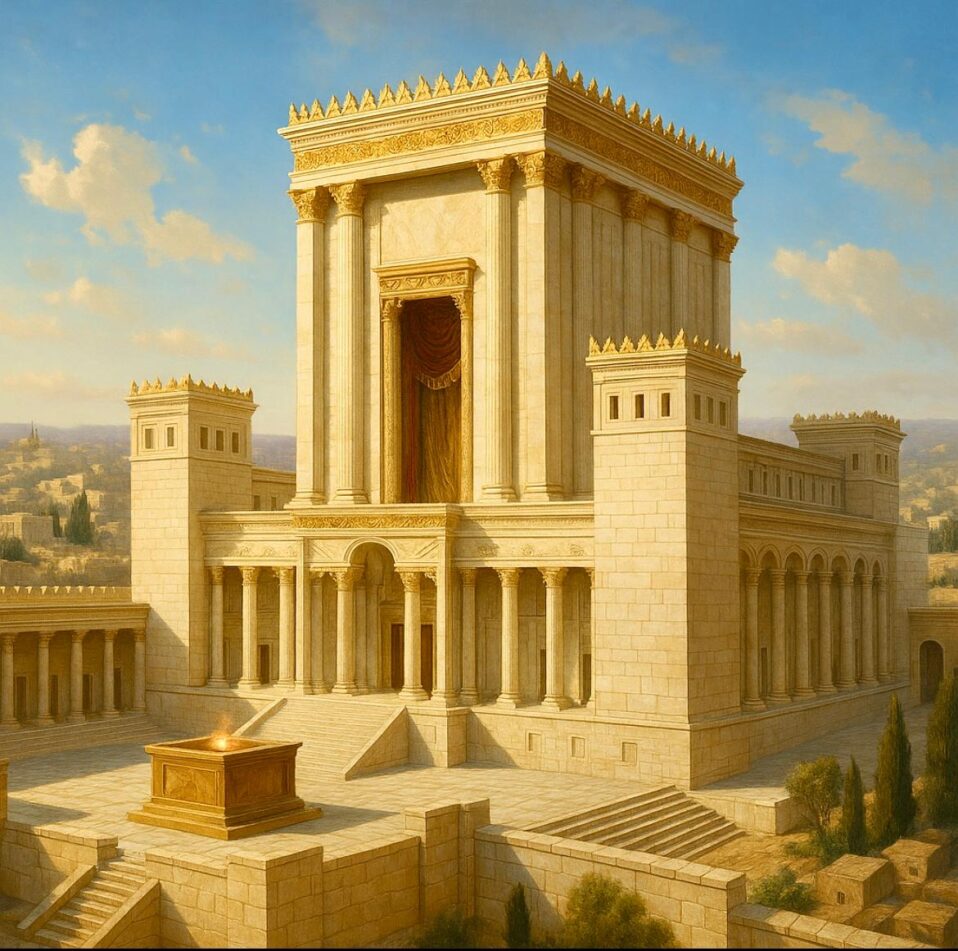As we begin the biblical new year (Exodus 12:2) this week, observant Jews around the world are reading Exodus 38:21 – 40:38. The passage constitutes this week’s traditionally set portion (parasha) of the annual Torah reading cycle. It describes final preparations that were to be made for Israel’s ancient tabernacle, before God’s glory came to fill it. The parasha also includes a specified reading from 1 Kings 7 and 8, highlighting the dedication of Israel’s First Temple.
Given this week’s Scriptural focus on the temple, along with recent news on the topic, now is an appropriate time to look afresh at the prophetic rebuilding of Israel’s Holy Temple. We will consider some rarely discussed, but very key implications, from a biblical and Messianic perspective.
Many Christians are deeply interested, even fascinated, with the rebuilding of Israel’s temple in Jerusalem. They see its future construction as a sign of Messiah’s soon return. They are excited about recent progress in the breeding of red heifers (cows), which are required under the Mosaic law for temple-related, ritual purification.
It may surprise you to learn that most Israeli Messianic Jews do not share this excitement. We acknowledge that Scripture indicates a third temple will be built and become operational. While we cannot know at this time for certain how all related details will unfold, we do have some Bible-based concerns. Allow me to explain.
Is the Third Temple the Future Fourth?
Consider that whenever Scripture refers to a third temple, it is in connection with the anti-Christ. Nowhere in the Bible is there any clear indication that God will actually take pleasure in this particular temple. (Daniel 9:25-27; Matthew 24:15; 2 Thessalonians 2:3-4; Revelation 13:5-7)
Sometimes, believers confuse the third temple with the glory temple described in Ezekiel chapters 40 – 47. But a careful reading shows they are different.
First, Ezekiel’s temple has no association with the anti-Christ or with anti-Christian influence. Second, according to Bible scholars, the physical dimensions of the temple outlined in Ezekiel total approximately 1 square mile. Currently, the size of the entire Old (biblical) City of Jerusalem measures only about 1/3 of 1 square mile. This means the temple described in Ezekiel cannot possibly fit within the confines of Jerusalem, let alone the Temple Mount, where Scripture indicates it is to be built. A third consideration is that God’s glory returns in fullness to Israel in Ezekiel 43 — but not in passages referencing the temple built before Messiah returns.
Given these particulars, the most likely interpretation of Ezekiel 40 – 47 is that the prophet describes a temple which exists in an era other than this present age. Many scholars believe it points to the glorious structure designed, erected and functioning during the Messianic Age. They see it as a fourth temple, distinct from the third. Christians usually call this future age the Millennium, the era during which Yeshua rules and reigns on earth, in Person, from Jerusalem, for “a thousand years.” (Revelation 20:4)
One reason some believers confuse Israel’s third and fourth temples is that Ezekiel’s temple includes animal sacrifices. Bear in mind, however, these sacrifices will not be offered to achieve the forgiveness of sins. Instead, they will likely serve as memorial, worship or thank offerings of God’s gracious redemption of the earth realm. Additionally or alternatively, animal sacrifices might conceivably serve to “reinforce” Yeshua’s once-for-all atonement for the sake of unsaved human beings living on earth when He returns. We cannot yet know for sure the full mind of the Lord on this intriguing matter. We do know that beautiful, probably unimaginable, expressions of worship will take place after He returns. These expression will presumably include animal sacrifice, and we will marvel at the mystery of God’s wisdom and ways.
When will the resplendent fourth temple be built? Ezekiel’s edifice might possibly be constructed from the bottom up when Yeshua returns. Some Jewish scholars believe, however, that it will result from an already existing, heavenly temple physically descending on the Temple Mount. Another possibility is that it proves to be a majestic combination of both.
Turning now from the issues of temple size and sacrifice, consider that Scripture indicates Israel’s third temple will be grievously defiled by the anti-Christ. In it this imposter will commit a horrendous evil known as the “abomination of desolation” (Daniel 9:25-27; Matthew 24:15; 2 Thessalonians 2:3-4). So a fair question to ask is whether the Holy One would inhabit, let alone rule from, such a devilishly defiled house and throne?
The answer is, maybe.
We can speculate that Yeshua might oversee a thorough cleansing and re-dedication of the temple after He returns. There is precedent for such in the historical account of Hanukkah, when Israel’s defiled Second Temple was cleansed and rededicated. (According to the biblical record, God’s glory never filled the Second Temple the same as the First. Years later, however, Yeshua visited the Second Temple, worshiped and taught in it.)
Possibly, God’s heavenly temple (Revelation 11:19) will merge with a cleansed third temple. Isaiah 2:2 hints at a major expansion of the Temple Mount from its present size: “The mountain of the Lord will be raised up,” presumably to a height much greater than it is now. In that case, the entire Old City of Jerusalem might be dramatically enlarged and able to accommodate a greatly expanded, rededicated third temple. Problem is, such a radical change would, in effect, amount to a wholly different type of “born again” (so to speak) fourth temple.
The Question of Animal Sacrifice
There is a much deeper issue to prayerfully consider pertaining to Israel’s third temple. The book of Hebrews explains, in no uncertain terms, that the sacrificial system functioning under the Mosaic law has now been fulfilled in the once-for-all atonement of Messiah Yeshua (Hebrews 7:12, 8:13, 9:11-14, and more). Hebrews 10:4 and 11 state: “It is impossible for the blood of bulls and goats to take away sins….Day after day every priest performs his religious duties; again and again he offers the same sacrifices, which can never take away sins.” The author of Hebrews builds on the principle of Isaiah 1:11-17, where God says He takes “no pleasure” in the blood of bulls, rams and goats if the people do not live righteously. Yet true righteousness before God comes solely by surrendering to divine grace through faith in Messiah Yeshua (2 Corinthians 5:21).
Interestingly, even the Talmud, a collection of ancient rabbinic writings with mixed levels of inspiration, contains an intriguing passage on the ineffectiveness of animal sacrifice. In a section identified as Yoma 39a, the Talmud records that every Yom Kippur (Day of Atonement), a red woolen thread was tied to the ritual scapegoat mandated by Leviticus 16:8-10. Year after year, the thread would miraculously turn white as a sign that Israel’s sins had been forgiven. But after Yeshua’s Crucifixion, the thread never again turned white. This perplexed and greatly troubled the Jews, and their leaders, who were not believers in Yeshua.
Assuming the Talmudic account is true, it confirms the New Covenant reality that animal sacrifices are ineffective for the forgiveness of sins, despite divine compassions, our good intentions, or wishful human thinking. We must consider that when the temple is rebuilt, most Jews (and even some Christians) will mistakenly put their trust back into rituals described as “old” or “obsolete” (Hebrews 8:13).
Most Jewish people today view Yeshua as a teacher or messiah for Gentiles only. When the temple is rebuilt and animal sacrifices resumed, they will think of Him as more irrelevant or inapplicable to them, the Jews, than ever. And so we must prayerfully consider whether a rebuilt temple is truly a good thing for Christians to overtly encourage and proactively support.
You might ask, Won’t God’s extend special grace toward His beloved Jewish people according to His everlasting, covenant favor? you might ask. Bear in mind that Yeshua said—specifically to the Jews—that He was the Way, Truth and Life, and that nobody comes to the Father but by Him (John 14:6). Likewise, Peter declared—specifically to the Jews—there is no other name by which they must be saved (Acts 4:12).
Further reinforcing anti-Messiah aspects of the third temple, certain rabbinic traditions teach that once it is functioning, Israel’s savior-messiah will soon arrive. Religious Jews expect their messiah to be entirely human, not divine, and a charismatic man who achieves global peace. Such an individual would fit the Bible’s description of an end times anti-Christ.
Mercy in the Temple
However matters unfold, God will be merciful. According to 2 Corinthians 3:15, “Whenever Moses is read, a veil lies over the hearts of the Jewish people, but whenever one turns to the Lord, the veil is taken away.”
Consider that the third temple will likely be spectacular in appearance and genuinely inspirational in beautiful grandeur. In it, praise and worship to YHVH will take place at a level not experienced on earth in thousands of years. Because God inhabits the praises of His people, Holy Spirit will likely grace the temple to a limited extent. I believe He will encounter those worshipers who wholeheartedly seek Him. Some will eventually realize the futility of the sacrificial system and genuinely turn to Him. As a result, the veil over their hearts will dissipate in Messiah’s love and light.
How Should We Pray?
As we pray, we should neither strenuously support nor vigorously oppose the rebuilding of Israel’s temple. Instead, we are to pray with biblical balance and discernment into unfolding prophetic events. We are to embrace the heart of God, longing for Israel to be saved (Romans 10:1). Here are 5 key ways to pray:
- Pray for God’s perfect timing and circumstances, that the temple be built only when He determines, in the specific manner He allows, and for His ultimate glory.
- Pray that resumed liturgical sacrifice will reveal the insufficiency of the blood of bulls, goats and other innocent animals for the forgiveness of sins, and point many Jewish people to Yeshua’s once-for-all atonement.
- Pray for Holy Spirit’s presence in the temple, removing the veil over those who seek Him wholeheartedly. Pray with the passionate heart of God, who desires Israel to be saved (Romans 10:1).
- Pray for biblical discernment for the Church, especially for overly zealous believers who vigorously support rebuilding the temple in a mistaken attempt to hasten the Lord’s return (2 Peter 3:12).
- Pray, as a priority, for the building and maturing of living temples; namely, Messianic Jewish and Arab Christian believers in Israel (1 Corinthians 3:16-17). For God so loved the world that He gave His only Son, that whoever believes in Him would not perish but have everlasting life!


